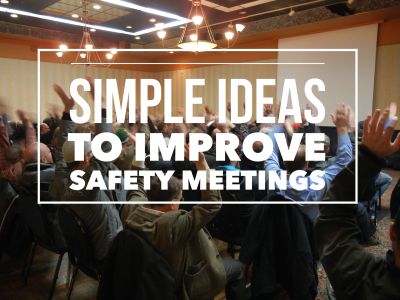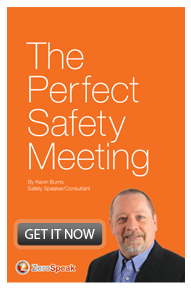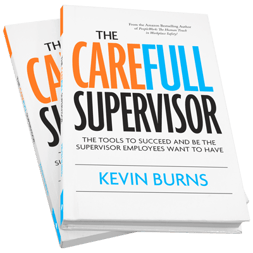If you want to improve safety meetings, you have to improve the level of respect you have for your people first.
 Mark Cuban, television personality and owner of the NBA’s Dallas Mavericks once said, “Never take meetings unless someone is writing a check.” He might be onto something there. Safety people would make a bigger effort if they got paid for the quality of their safety meetings.
Mark Cuban, television personality and owner of the NBA’s Dallas Mavericks once said, “Never take meetings unless someone is writing a check.” He might be onto something there. Safety people would make a bigger effort if they got paid for the quality of their safety meetings.
But that’s not happening anytime soon. So, for now, you will have to accept that safety meetings are notorious time killers. They usually start late, discuss too many topics, and end up running long. Poor planning combined with poor presentation skills make them difficult to endure.
If your people can’t wait to attend the next safety meeting, and are excited when it’s meeting day, then you’re doing it right. But that’s not you is it? So how about you invest a few minutes and give some consideration to some new ideas. Like a good safety meeting, it’ll be short and to the point.
Here are three easy steps that can transform your safety meetings from boring to engaging - and build respect:
1Upgrade your people-view. Your people-view is the way in which you view your people. Your people-view will determine how you approach and treat your people. Do you view them as highly-skilled professionals? Are they experienced and tight units? Or, are they grunts that have short attention spans (I kid you not, this is how I’ve heard some safety people describe their crews)? Your people view will determine the way in which you respect or disrespect your crews. Are your crews worthy of your very best? Or is “good enough” good enough? If you view your people as crews of highly-skilled and professional, you will treat them as professionals. Professionals don’t need to be lectured. You will treat them with dignity. You will provide them with the essential information they need to perform at a high level. You won’t muddy your meetings with information dumps. Upgrade your people view and you will upgrade the level of preparation and presentation at safety meetings. Don’t dumb-it-down, unless you think that’s all they’re capable of comprehending. Then, that might be an issue with your people-view.
2Start on time - end early. One of life’s great annoyances is having to sit around and wait for a meeting to begin. Attendees who arrive at the meeting on time and have to wait for those that are late end up being penalized for being on time. That’s disrespect; by both the meeting chair and the latecomers who can’t be bothered to arrive on time. Attempting to solve technical issues (computer, projector, etc.) at the last minute also speaks to respect levels - or lack thereof. It shows how unprepared the meeting organizer is. Isn’t the point of a safety meeting to help your people be prepared? Being unprepared and holding-up the meeting undermines the integrity of safety. You don't look professional when you start late, try to solve last-minute technical issues and run late. If employees are expected to sign-in for a meeting, open up registration 15 minutes prior to meeting start. Provide enough sign-in sheets to accommodate many attendees at once. Don’t make them wait in long lines which holds up the meeting. Be prepared. Start on time. End early, whenever possible. No one ever complained that the safety meeting was too short.
3Work backwards.
 What is the point of this meeting and what do you want your people to do differently as a result of the meeting? These are two questions that you should have an answer for before you even begin to organize the meeting. Safety meeting attendees what to know why they are there; what they’re going to learn; why it’s important; and what you want them to do differently/better? Establish what you want them to do differently (or better). You can’t organize a successful safety meeting without a purpose. What do they need to know today that will improve their safety? Why do they need to know it? Once they get the information, what specific steps do you want them to take? Start at the end of the meeting and work backwards. Determine your purpose for the meeting. Identify a specific call-to-action you will want them to take. Then, point every item in your safety meeting at accomplishing that one thing.
What is the point of this meeting and what do you want your people to do differently as a result of the meeting? These are two questions that you should have an answer for before you even begin to organize the meeting. Safety meeting attendees what to know why they are there; what they’re going to learn; why it’s important; and what you want them to do differently/better? Establish what you want them to do differently (or better). You can’t organize a successful safety meeting without a purpose. What do they need to know today that will improve their safety? Why do they need to know it? Once they get the information, what specific steps do you want them to take? Start at the end of the meeting and work backwards. Determine your purpose for the meeting. Identify a specific call-to-action you will want them to take. Then, point every item in your safety meeting at accomplishing that one thing.
There are safety meetings that are boring and disengaging. There are safety meetings that are engaging and enjoyable. Which are yours? Truthfully. What is it that you have to do to make them engaging and enjoyable? Do the work. Your people deserve your respect. It’s safety. It matters.
For more ideas and strategies on safety meetings, and especially people-view, buy the book PeopleWork: The Human Touch in Workplace Safety. It's available around the world on Amazon.
Kevin Burns has authored ten books on human performance and safety, including his most recent release, PeopleWork - The Human Touch in Workplace Safety. Buy it now on Amazon. Then, consider bringing Kevin's consulting expertise to your company or have him speak at a safety event.
©2017 ZeroSpeak Corporation and Kevin Burns.
No part of this post may be reproduced without the expressed consent of the author.



